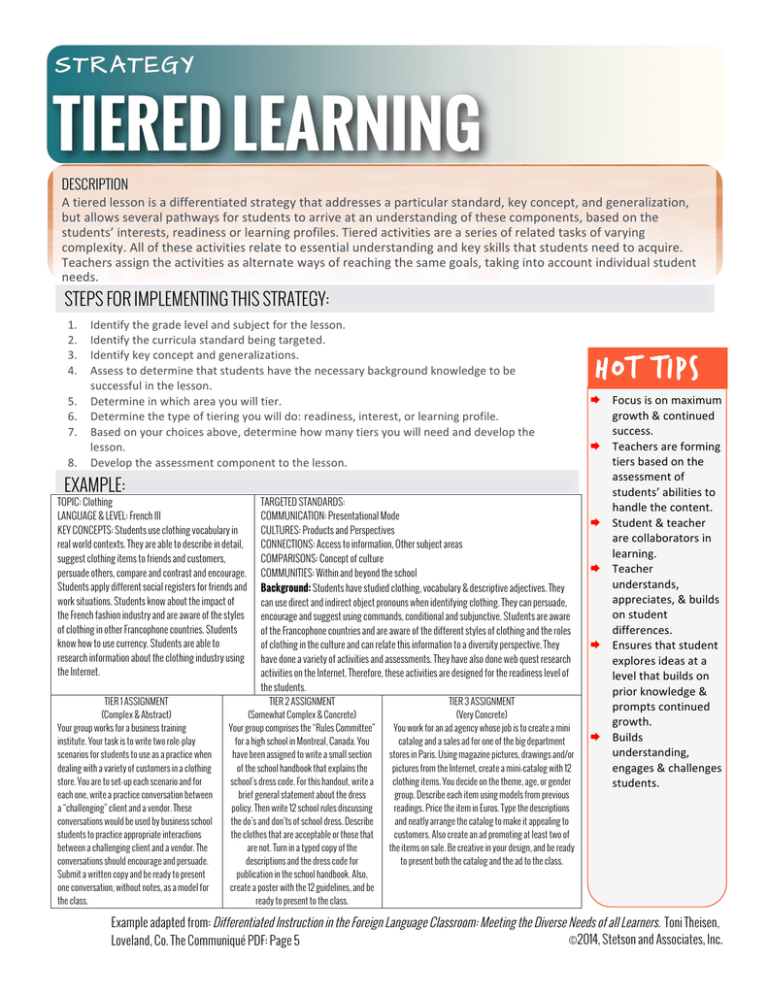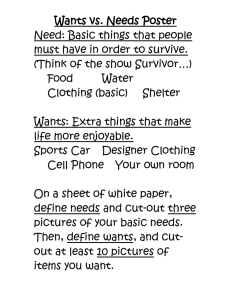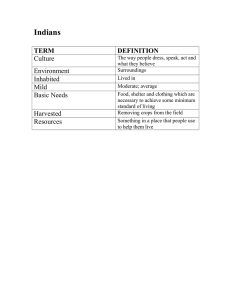Tiered Learning Strategy LB NEW
advertisement

STRATEGY DESCRIPTION TIERED LEARNING A tiered lesson is a differentiated strategy that addresses a particular standard, key concept, and generalization, but allows several pathways for students to arrive at an understanding of these components, based on the students’ interests, readiness or learning profiles. Tiered activities are a series of related tasks of varying complexity. All of these activities relate to essential understanding and key skills that students need to acquire. Teachers assign the activities as alternate ways of reaching the same goals, taking into account individual student needs. STEPS FOR IMPLEMENTING THIS STRATEGY: 1. 2. 3. 4. 5. 6. 7. 8. Identify the grade level and subject for the lesson. Identify the curricula standard being targeted. Identify key concept and generalizations. Assess to determine that students have the necessary background knowledge to be successful in the lesson. Determine in which area you will tier. Determine the type of tiering you will do: readiness, interest, or learning profile. Based on your choices above, determine how many tiers you will need and develop the lesson. Develop the assessment component to the lesson. EXAMPLE: TOPIC: Clothing LANGUAGE & LEVEL: French III KEY CONCEPTS: Students use clothing vocabulary in real world contexts. They are able to describe in detail, suggest clothing items to friends and customers, persuade others, compare and contrast and encourage. Students apply different social registers for friends and work situations. Students know about the impact of the French fashion industry and are aware of the styles of clothing in other Francophone countries. Students know how to use currency. Students are able to research information about the clothing industry using the Internet. TIER 1 ASSIGNMENT (Complex & Abstract) Your group works for a business training institute. Your task is to write two role-play scenarios for students to use as a practice when dealing with a variety of customers in a clothing store. You are to set-up each scenario and for each one, write a practice conversation between a “challenging” client and a vendor. These conversations would be used by business school students to practice appropriate interactions between a challenging client and a vendor. The conversations should encourage and persuade. Submit a written copy and be ready to present one conversation, without notes, as a model for the class. TARGETED STANDARDS: COMMUNICATION: Presentational Mode CULTURES: Products and Perspectives CONNECTIONS: Access to information, Other subject areas COMPARISONS: Concept of culture COMMUNITIES: Within and beyond the school Background: Students have studied clothing, vocabulary & descriptive adjectives. They can use direct and indirect object pronouns when identifying clothing. They can persuade, encourage and suggest using commands, conditional and subjunctive. Students are aware of the Francophone countries and are aware of the different styles of clothing and the roles of clothing in the culture and can relate this information to a diversity perspective. They have done a variety of activities and assessments. They have also done web quest research activities on the Internet. Therefore, these activities are designed for the readiness level of the students. TIER 2 ASSIGNMENT (Somewhat Complex & Concrete) Your group comprises the “Rules Committee” for a high school in Montreal, Canada. You have been assigned to write a small section of the school handbook that explains the school’s dress code. For this handout, write a brief general statement about the dress policy. Then write 12 school rules discussing the do’s and don’ts of school dress. Describe the clothes that are acceptable or those that are not. Turn in a typed copy of the descriptions and the dress code for publication in the school handbook. Also, create a poster with the 12 guidelines, and be ready to present to the class. TIER 3 ASSIGNMENT (Very Concrete) You work for an ad agency whose job is to create a mini catalog and a sales ad for one of the big department stores in Paris. Using magazine pictures, drawings and/or pictures from the Internet, create a mini-catalog with 12 clothing items. You decide on the theme, age, or gender group. Describe each item using models from previous readings. Price the item in Euros. Type the descriptions and neatly arrange the catalog to make it appealing to customers. Also create an ad promoting at least two of the items on sale. Be creative in your design, and be ready to present both the catalog and the ad to the class. HOT TIPS Æ Focus is on maximum growth & continued success. Æ Teachers are forming tiers based on the assessment of students’ abilities to handle the content. Æ Student & teacher are collaborators in learning. Æ Teacher understands, appreciates, & builds on student differences. Æ Ensures that student explores ideas at a level that builds on prior knowledge & prompts continued growth. Æ Builds understanding, engages & challenges students. Example adapted from: Differentiated Instruction in the Foreign Language Classroom: Meeting the Diverse Needs of all Learners. Toni Theisen, ©2014, Stetson and Associates, Inc. Loveland, Co. The Communiqué PDF: Page 5 2

